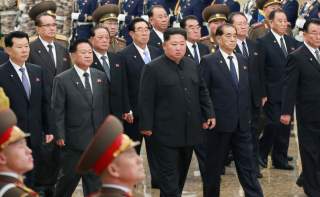ICBMs or Negotiations: What Path Will North Korea Take?
Here are three paths Kim Jong-un may decide to take if negotiations don’t magically resume before New Years Day.
One can always hope and pray that the United States and North Korea both see the light of day and discover a way to break the diplomatic logjam before the New Year hits the calendar. But hope is not a policy—and by the looks of U.S. envoy Stephen Biegun’s unproductive, three-day trip to South Korea this week, Washington is staring at a diplomatic initiative struggling to sustain itself like a fish out of water. Biegun’s only public remarks in Seoul were used to hammer the North Koreans for obstructing the process, a message that could do more harm than good in moving Kim Jong-un back into cooperation mode.
It’s, therefore, an urgent necessity for national security officials across the inter-agency, including the intelligence community, to begin planning for what could happen next year. Will President Trump’s diplomatic gamble with the North survive the turn of the new year? Is Kim even interested in discussing anything with the United States anymore? Have we gotten to the point where U.S.-North Korea relations are destined for permanent hostility? Is Washington prepared to swallow its pride and set its sights on more achievable objectives, throwing denuclearization to the wind?
Predicting what Kim Jing-un will do a month from now, let alone a year from now is pretty much asking for failure. But predictions need to be made regardless; the worst thing a U.S. president can do is get caught with his pants down. So in the spirit of the prediction business and with those usual caveats in mind, here are three paths Kim Jong-un may decide to take if negotiations don’t magically resume before New Years Day.
1. No More Bilateral Talks?: Kim Jong-un’s tolerance for diplomacy has been challenged throughout 2019 by a mixture of factors, including unrealistic expectations of what Trump would offer and the hangover that has persisted after his disappointing second summit meeting in Hanoi. The North Korean leader sees less of a reason to abide by his unilateral moratorium on long-range missile and nuclear tests in this environment and has threatened through his subordinates that the testing freeze could be lifted if Washington doesn’t begin making moves to improve the bilateral relationship. 13 rounds of ballistic missile tests later, “dotard” is once again reappearing in the Kim regime’s vocabulary.
Kim may come to the conclusion that further talks with the United States are a waste of valuable time and a reward for what Pyongyang’s views as the Trump administration’s bad behavior over the previous 10 months. The inter-Korean reconciliation discussions which proceeded with such promise in 2018 could be cut short, partly because Washington holds a veto over the process and partly because South Korean President Moon Jae-in has been powerless to match up to his promises. Seoul’s Unification Ministry flags a collapse of diplomacy as a very real option: “If there is no progress in North Korea-US negotiations by the year-end deadline, the possibility of North Korea’s leader declaring the suspension of the talks in his New Year’s address cannot be ruled out.”
2. A Shift to Multilateral Talks: Bilateral negotiations over the last 18 months have yet to result in any concrete concessions for the North. Kim may calculate that more players need to be around the table, both to water down Washington’s demands and to send a signal to the White House that the United States isn’t the only player in the game. A return to the Six-Party Talks format, while unlikely, is not impossible. Indeed, China and Russia explicitly called for a return to the Six-Party Talks in their jointly-crafted U.N. Security Council Resolution, an assurance that a North Korean request to broaden the number of participants would have the support of these two key stakeholders. This would allow Kim to throw a wrench into Washington’s diplomatic strategy while simultaneously keeping a dialogue open and increasing the pressure on Trump to either accept the offer (and look like he’s capitulating to North Korean demands) or reject it (in which case Trump looks like the primary obstacle to progress).
3. Hold fast and press on: Of course, the status-quo cannot be ruled out. Kim could hold fast on his position, test additional ballistic missiles of larger range, and improve his bilateral relationship with Beijing and Moscow in order to alleviate the impact of U.S. and U.N. sanctions that are clearly depriving the regime of the resources it would otherwise have. It’s not unreasonable for Kim to assess that the longer the status quo continues, the more exhausted the Chinese and Russians will be with the U.S. strategy and the more likely they will turn a blind eye to more frequent violations of the sanctions. While North Korea would remain a pariah in the eyes of much of the world, the country would still be able to carry on. Were Kim to order another ICBM test, however, he would run the high risk of taking this option away.
What path will Kim take?
Daniel DePetris is a fellow at Defense Priorities, a foreign policy organization focused on promoting a realistic grand strategy to ensure American security and prosperity.

